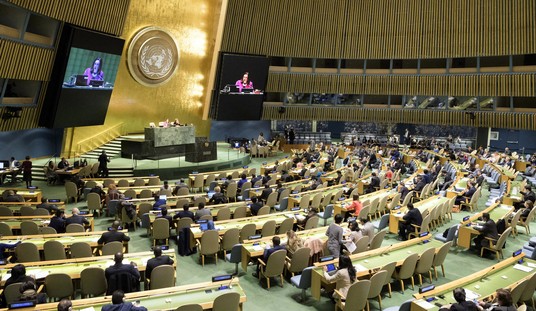Just as the flood waters recede from Texas, Florida finds itself in the path of another massive hurricane. The National Weather Service now calls Hurricane Irma a Category 5 storm, the most destructive of its rankings, even worse than Hurricane Harvey’s Category 4 rating. Irma will cut across Puerto Rico, Cuba and the Keys before taking aim at southern Florida, and the only question will be where precisely it will make landfall:
Hurricane Irma is now a Category 5 storm & could reach Florida by the end of the weekened. Gov. Rick Scott has declared a state of emergency pic.twitter.com/O0qiwtVD6q
— CBS News (@CBSNews) September 5, 2017
Irma’s maximum sustained winds increased to 175mph (280 kph) early Tuesday. It was centered about 270 miles (440 kilometers) east of Antigua and moving west at 14 mph (22 kph).
Authorities warned that the storm could dump up to 10 inches (25 centimeters) of rain, cause landslides and flash floods and generate waves of up to 23 feet (7 meters). Government officials began evacuations in certain islands.
The likelihood of Irma dissipating before it hits its closest targets is practically nil, and the odds aren’t much better for Florida if it does make landfall there. Weather Channel meteorologist Heather Tesch told NBC News that the storm is moving toward warmer waters, which means it’s likely to pick up even more strength. As it is now, they expect storm surges between six to nine feet and massive destruction from both wind and water.
How bad might it get? The chief of Puerto Rico’s power utility gave this dire outlook:
The director of the Puerto Rico’s power company predicted that storm damage could leave some areas without electricity for four to six months. But “some areas will have power (back) in less than a week,” Ricardo Ramos told radio station Notiuno 630 AM. The utility’s infrastructure has deteriorated greatly during a decade-long recession, and Puerto Ricans experienced an island wide outage last year.
There’s a lot of dysfunction in Puerto Rico that goes into that, too, but the result will be the same. Four months or more of no electricity will create a humanitarian crisis that would far surpass what Texas can expect after Harvey, in depth but not in scope. Without power, there can be no rebuilding, no re-emergence of a rational economy, and most importantly, no refrigeration for perishable foods. Presumably hospitals and clinics can run on generators, but that will depend on fuel shipments.
The Coast Guard has begun to prepare for Irma’s arrival by transferring assets from Texas:
For the first time since Hurricane Harvey made landfall on Aug. 25, the Coast Guard did not have to carry out rescue missions in storm-ravaged Southeast Texas on Sunday. Instead, the service began moving a number of helicopters out of Texas and into Puerto Rico, Florida and Georgia, in anticipation of another landfall threat brewing for the U.S. coast: Hurricane Irma.
“As soon as one ends, we need to make sure we are ready for the next event,” Adm. Paul Zukunft, the Coast Guard commandant, said Monday as Irma, which had become a Category 4 hurricane by late in the day, churned in the Atlantic.
It is still too early to determine exactly where and when Irma will hit, but model forecasts indicate it is increasingly likely to affect the United States. The National Hurricane Center warned in a 4 a.m. update Tuesday that Irma — depending on its path — could impact the British and U.S. Virgin Islands, Puerto Rico, the Bahamas, Cuba and the Leeward Islands. A significant percentage of model forecasts have Irma striking the U.S. East Coast as early as Saturday or Sunday, with tropical storm winds arriving in Florida as soon as Friday.
Out of the frying pan and into the fire. At least Florida has plenty of time to prepare for the storm. The big question will be just how badly they get hit — and whether Irma pushes into the Gulf toward Harvey’s impact area. The Coast Guard might need to make a return trip.
Update: I had meant to make this point, but inadvertently left it out:
Define "worse". Harvey was weaker when it made landfall, but then sat for a week dumping rain.
Irma doesn't look likely to do the last part.— “Dr.” The Monster (@SumErgoMonstro) September 5, 2017
Irma is more powerful, but perhaps won’t be worse than Harvey in terms of destruction. Harvey parked itself over the Texas coast for days on end before finally moving inland. Irma seems set to keep moving, but that’s not easily predictable at this point.
Update: Be sure to also read Glenn Reynolds’ tribute to “real America” and its response to Harvey:
The government response to Harvey — unlike the earlier botched responses to Hurricanes Katrina and Sandy — seems to be going well. But the real story isn’t what the government is doing. It’s what ordinary Americans are doing.
Across the affected area, Americans are coming together to help each other. Despite the racial divisions exacerbated by small numbers of fanatics on the left and right, (and amplified by the press), out in the real America white people, black people and Asians helped each other, men rescued women and children, and so on. The “Cajun Navy,” which had so distinguished itself in response to flooding in Louisiana, took its boats to Texas and started saving people.
People formed human chains to rescue victims, a black man (sent via Chik-fil-A) rescued an elderly white woman from her home on a jet-ski, driving it right out of her flooded living room. Some of the people helping were rich, others clearly were not. Likewise those they helped. The photos of rescuers and rescued show the kind of wide-ranging diversity that our colleges and corporations aspire to, but usually fail to deliver.
Asked what he was going to do as he prepared his boat, a Texas man responded, “I’m gonna try to save some lives.” A report from Agence France Presse said it best: “In Devastated Houston ‘Nobody Hates Anybody’ As People Come Together.”








Join the conversation as a VIP Member